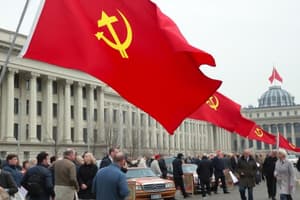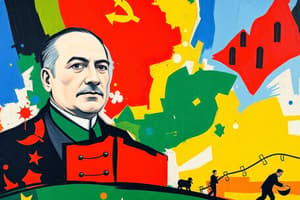Podcast
Questions and Answers
What was one outcome of War Communism regarding urban populations?
What was one outcome of War Communism regarding urban populations?
- Urban population decreased by 25%. (correct)
- The urban population increased by 50%.
- Factories remained operational due to sufficient rations.
- Housing was restricted for urban workers.
What impact did the New Economic Policy (NEP) have on the workforce?
What impact did the New Economic Policy (NEP) have on the workforce?
- Unemployment increased as soldiers were demobilized. (correct)
- Labor discipline was relaxed during this period.
- It favored the hiring of women in the workforce.
- It resulted in increased job security for all workers.
Which statement correctly describes social benefits during this period?
Which statement correctly describes social benefits during this period?
- Workers' rights were fully granted to all social classes.
- Social insurance provided comprehensive welfare to peasants.
- Social insurance was limited to union members only.
- Canteens were established to supply meals for workers. (correct)
What was a significant limitation of the welfare system mentioned?
What was a significant limitation of the welfare system mentioned?
What aspect of the welfare system saw improvements during this period?
What aspect of the welfare system saw improvements during this period?
Flashcards
Compulsory Labor (War Communism)
Compulsory Labor (War Communism)
All able-bodied adults between the ages of 16 and 50 were required to work in factories, farms, or other industries during the Soviet government's implementation of War Communism.
Unemployment under the NEP
Unemployment under the NEP
During the New Economic Policy (NEP), a period of economic recovery after War Communism, soldiers were discharged, workers were let go, and unemployment rose significantly.
Labor Discipline under NEP
Labor Discipline under NEP
During the New Economic Policy (NEP), workers faced strict labor discipline and controls. They were expected to work hard and follow orders.
Social Insurance in Soviet Union
Social Insurance in Soviet Union
Signup and view all the flashcards
Government Investment in Education for Peasants
Government Investment in Education for Peasants
Signup and view all the flashcards
Study Notes
Soviet Economic Policy
- Soviet economic policy prioritized distributing wealth, but secondary to other priorities
- All able-bodied adults required to work (16-50 yrs).
- War Communism failed
- Work card system for social benefits
- Food and fuel rationed (Prodraspred)
- Housing and transport free for urban workers
- 1920 food rations insufficient, leading to factory abandonment, urban population decline by 25%
The NEP (New Economic Policy)
- Introduced in 1924
- 18% of urban workers unemployed
- Soldiers demobilized, contributing to unemployment
- Workers dismissed for efficiency
- Women discouraged from work, no crecine
- Social insurance included disability, maternity, and medical benefits
- Government investment in peasant education
Social Security (1917-1953)
- Significant changes in labor discipline and living conditions
- Labour discipline became harsher under Stalin
- Working conditions were dangerous
- Living conditions show slight improvement.
- Social benefits included transportation (metro), railway, and vaccines (universally available by 1947)
- Canteens provided meals for workers.
- Problems in welfare existed.
Studying That Suits You
Use AI to generate personalized quizzes and flashcards to suit your learning preferences.




